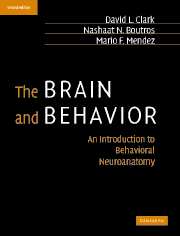Book contents
- Frontmatter
- Contents
- Preface
- 1 Introduction
- 2 Gross anatomy of the brain
- 3 Histology
- 4 Occipital and parietal lobes
- 5 Temporal lobe – neocortical structures
- 6 Frontal lobe
- 7 Basal ganglia
- 8 Diencephalon: hypothalamus and epithalamus
- 9 Diencephalon: thalamus
- 10 Brainstem
- 11 Limbic system: temporal lobe
- 12 Limbic system: cingulate cortex
- 13 Limbic system: overview
- 14 Interhemispheric connections and laterality
- Index
- Plate section
- References
14 - Interhemispheric connections and laterality
Published online by Cambridge University Press: 25 August 2009
- Frontmatter
- Contents
- Preface
- 1 Introduction
- 2 Gross anatomy of the brain
- 3 Histology
- 4 Occipital and parietal lobes
- 5 Temporal lobe – neocortical structures
- 6 Frontal lobe
- 7 Basal ganglia
- 8 Diencephalon: hypothalamus and epithalamus
- 9 Diencephalon: thalamus
- 10 Brainstem
- 11 Limbic system: temporal lobe
- 12 Limbic system: cingulate cortex
- 13 Limbic system: overview
- 14 Interhemispheric connections and laterality
- Index
- Plate section
- References
Summary
A hallmark of human brain function is cerebral lateralization and specialization. This specialization necessitates an efficient interhemispheric communication system. No other mammal possesses the degree of localization of function seen in the human. Only the human brain has the intellectual and computational capabilities necessary to study how neural systems both generate and respond to the intense information demands of the environment.
At first glance the anatomical brain appears largely symmetrical. More careful analysis reveals “typical counterclockwise hemispheric torque,” which is reflected in the fact that the left parieto-occipital region is wider and extends further posteriorly than the right. On the right side the frontal lobe is larger than the left and extends further anteriorly (Glicksohn and Myslobodsky, 1993). This difference is called petalia (Hadziselimovic and Cus, 1966). Fiber bundles interconnect the left and right sides. It must be assumed that these bundles play a role in the behavioral specializations that are reflected in the laterality of behavior.
Cerebral blood flow is greater on the right than on the left in infants. Left parietal dominance emerges at about 2½ years concordant with the onset of right-handedness and improved motor skills. Cerebral blood flow dominance shifts from right to left during the third year of life (Chiron et al., 1997).
Speech has long been recognized to be localized in the left (dominant) hemisphere. The right hemisphere has been hypothesized to be specialized in emotional and visuospatial functions that are important in survival of the species (Geschwind and Galaburda, 1985). Norepinephrine and serotonergic pathways project more heavily to the right hemisphere (Robinson, 1985).
Information
- Type
- Chapter
- Information
- The Brain and BehaviorAn Introduction to Behavioral Neuroanatomy, pp. 239 - 254Publisher: Cambridge University PressPrint publication year: 2005
